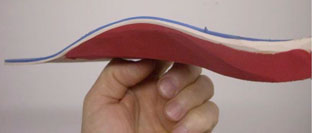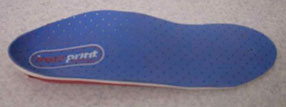Improve Your Skiing and Snowboarding with Custom Footbeds
Why do you need custom footbeds for ski boots?
Remember getting out of the pool last summer and looking at the tracks your wet feet left on the concrete? It is likely that the impression left didn't look anything like your foot, as only the ball and heel of your foot actually touched the concrete. For most people, the part of their foot that isn't visible in their footprint - the arch of the foot - is the area that can potentially cause the most problems; in everyday life and in sports. When skiing or snowboarding, for example, it is critical that your boots provide adequate arch support to ensure comfort, strong responsive edging and stable balance. Unfortunately, the typical ski and snowboard boots are built with cheap, overly cushioned footbeds that provide minimal arch support.
What type of footbed should I buy?
Fortunately, ski shops offers several types of customizable footbeds (also called orthotics) that can make the typical skiing or snowboarding boot more comfortable and supportive. One of the most cost effective options is the Downunder Footbed, available for $35. This footbed has a solid arch and reasonable support around the very important weight bearing heel.
A second, more enhanced footbed is the Zapz, available for $60. Zapz are very similar to the Downunders, but offer the consumer quick, customized arch support after being warmed in a microwave.
A higher end option is a hand-crafted, customized footbed that fits your foot alone. Though customized footbeds do not correct longstanding musculoskeletal deformities, by accommodating your foot to the boot, they can improve your performance on the ski slope. In this way, customized footbeds are similar to orthotic devices, which are made by foot doctors and are typically more costly.
How are custom footbeds made?
To create a customized footbed, a bootfitter will take time to evaluate your foot by looking at pronation/suppination (which way the ankle rolls), how high or low your arches are, and several other areas. After the initial examination, they position your feet in a pliable casting machine. They heat a flat piece of rubbery plastic in the oven, and then put this warm and pliable footbed between your foot and the casting machine, which quickly hardens to make a replica of the bottom of your foot. After this is done, the footbed is glued to some posting material (foam rubber) and the bottom is ground flat so your foot is stable in the boot and does not roll around.

Your boot technician will take your original, unsupportive footbeds out of old or new boots and replace them with your customized footbeds. If you are replacing the footbeds in old boots, your boot technician will examine the boots to let you know if there are any fit problems that would require you to purchase a new pair.
What should I look for when buying custom footbeds?
When shopping around for the person/business to make your footbeds, Steve Green recommends finding someone who has had specialized training in making footbeds. He is partial to technicians trained at Masterfit University, one of the premier winter sports footbed training sources. You should also look for someone who takes the time to examine your foot/leg alignment and performs a complete examination of your feet and boots. Another way to identify quality footbed producers is to ask your ski and snowboard school for their recommendations. You can also ask what footbed brand the store sells and why they prefer it. Some footbeds are cast non-weighted, while others are weighted - there are different philosophies behind each technique.

Closing thoughts
This whole process is like building a house. Consider the footbed as your foundation and make sure it is sound and solid underneath your house. With a customized footbed, when your foot moves, the boot is going to move comfortably with it. Your arches will have excellent support, and your feet will be much less likely to hurt or go to sleep. There are many different methods, materials, and opinions on how to make good customized footbeds, but all will improve the time you spend on the slopes.
Steve Green is co-owner of High Mountain Sports in Deep Creek, MD, www.highmountainsports.com. Steve spent many years as a ski instructor while working nights at the ski shop. In 1991 he became a partner in High Mountain Sports. Steve enjoys snow skiing several times a week, ski racing, wakeboarding and waterskiing, and restoring his 1979 Bombardier Snowcat.
